FIRST LOOK! 2013 KAWASAKI KX450F: THE MOST POWERFUL MOTOCROSS BIKE IN THE 450 CLASS GETS UPDATED

THE 2013 KX450F AT A GLANCE:
New Kayaba Pneumatic Spring Fork (PSF) replaces the main fork springs with compressed air to reduce weight, provide easier and more effective tuning and improve bottoming resistance.
Revised engine tuning offers more power and smoother delivery from basement revs through mid and into the upper rpm range; this provides more thrust while exiting corners and all the way down the straights, while also enhancing rider confidence.
Revised piston crown improves ultra-low to mid-range engine response.
Revised intake cam features slightly less lift, to promote better low-rpm throttle response.
New front master cylinder features a knocker-style lever-to-piston interface for improved feel and more consistent performance than the old piston-type unit.
New longer, lower density grips make life easier on the rider’s hands. They also extend further towards the center of the handlebars, allowing riders to move their hands up to 20mm closer together.
New lightweight 240mm petal-type rear rotor features the same aggressive petal style as the front rotor and is gripped by a single piston hydraulic rear caliper.
Launch Control improves low-gear acceleration by helping to reduce wheelspin during the run to the first corner.
Pre-programmed ignition maps are interchangeable trackside, no PC required.
Adjustable 4-position handlebar and 2-position footpegs allow riders to fit the KX to match their personal preference.
Black Anodized Aluminum rims for a factory look.

LAUNCH CONTROL MODE
Push-button activation of the Launch Control Mode retards ignition timing in first and second gears, giving the greatest effect within the first few seconds of releasing the clutch. Launch Control can be activated in neutral, first or second gear. Shifting into third gear automatically deactivates Launch Control Mode and returns the ignition to normal mapping.
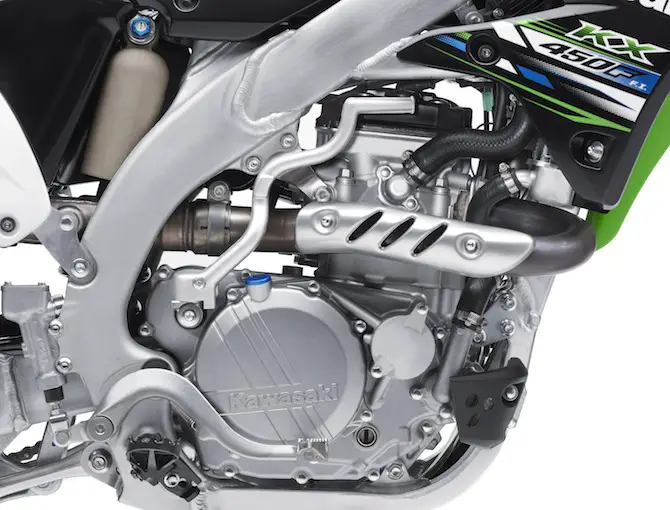
2013 KX450F ENGINE OVERVIEW
449cc liquid-cooled, DOHC, four-stroke single with legendary Kawasaki power.
Works-based Bridged-box Bottom piston has optimum rigidity for maximum high-rpm power and durability.
A forward lean angle of 3ø puts the engine in the ideal position for maximum traction.
Highly balanced crankshaft, on par with Villopoto’s factory racer, creates minimal vibration and has a high inertial mass to help maximize rear wheel traction.
Compact cylinder head is only 100mm tall.
Double valve springs help ensure stable valve operation and also allow for a short cylinder head height.
Digital Fuel Injection (DFI) self-adjusts to atmospheric changes for easier starting, sharper throttle response and accessible power for jumping.
It is not necessary to re-tune, or change any jets to suit climatic conditions like carbureted models.
Ultra-fine atomizing injector with 12 holes sprays particles with a droplet size of 60, for smooth power delivery and engine response throughout the throttle range.
43mm throttle body uses a progressive throttle linkage to deliver airflow in much the same way as an FCR carburetor.
Using two linked shafts, the throttle body opens more quickly after reaching the 3/8 open position.
Fast-idle knob on the throttle body allows riders to increase engine speed when starting a cold engine.
Fuel injector set at 45ø, the optimum angle for mid-range power.
Revised airbox flap helps prevent mud and water from entering, but has enlarged access hole to simplify air filter maintenance.
Camshafts, lobes and tappet surfaces feature a soft-nitride treatment for long wear and high-rpm reliability.
Automatic cam chain adjuster is maintenance-free.
Crankshaft and connecting rod feature a special carburizing and quenching treatment to maximize rigidity, boosting long term reliability without adding weight
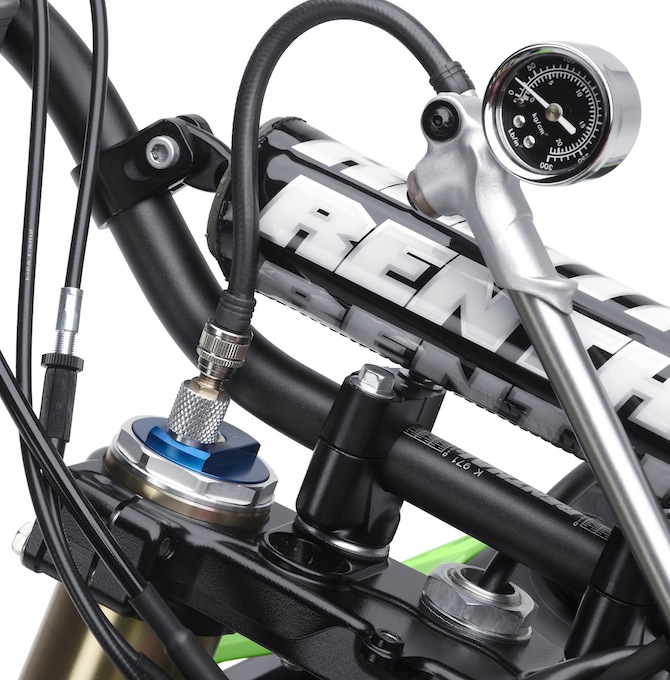
KAYABA PNEUMATIC SPRING FORK (PSF)
New 48mm KYB Pneumatic Spring Fork (PSF) eliminates the main fork springs by using compressed air as a spring. The reduced weight and inertia of the air spring improves smoothness and enhances the fork’s ability to follow terrain contours.
Air spring significantly reduces friction and cuts weight by 1.7 lbs. per set, while also providing better bottoming resistance, less oil contamination, plus easier and more effective tuning.
Larger 32mm diameter internal damping cartridges allow the use of pistons with approximately twice the surface area as last year’s 24mm AOS damper pistons. This provides more consistent performance and enhances bottoming resistance.
Diamond-Like Carbon (DLC) coating on the outer surface of the inner fork tubes offers minimum stiction when the fork is exposed to lateral forces that would usually hamper slide action. The result is improved fork response, especially during cornering.
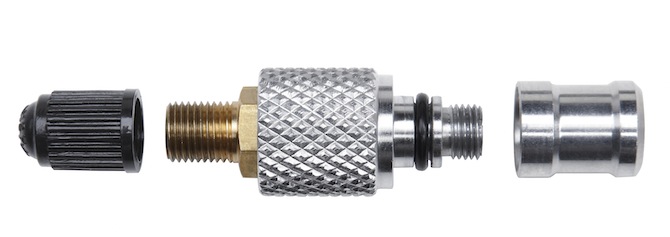
A removable spring pressure adjustment valve is included to simplify connection of an air pump.
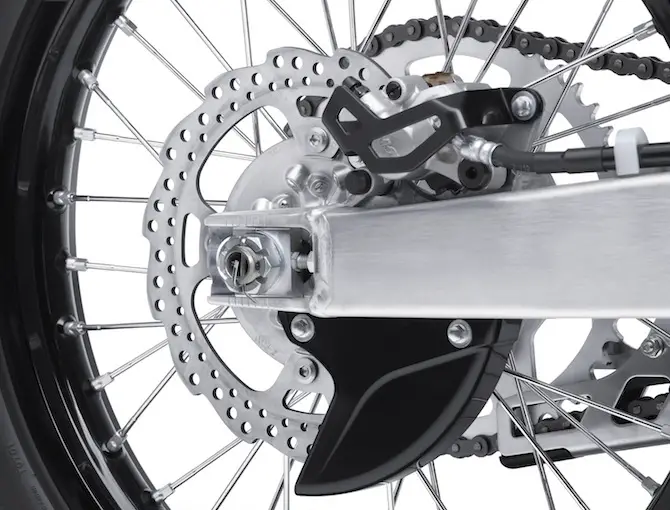
2013 BRAKES
Lightweight 250mm front rotor is squeezed by a powerful twin-piston caliper and features an aggressive petal design to help clear mud and debris.
New lightweight 240mm petal-type rear rotor features with the same aggressive petal style as the front rotor and is gripped by a single piston hydraulic rear caliper.
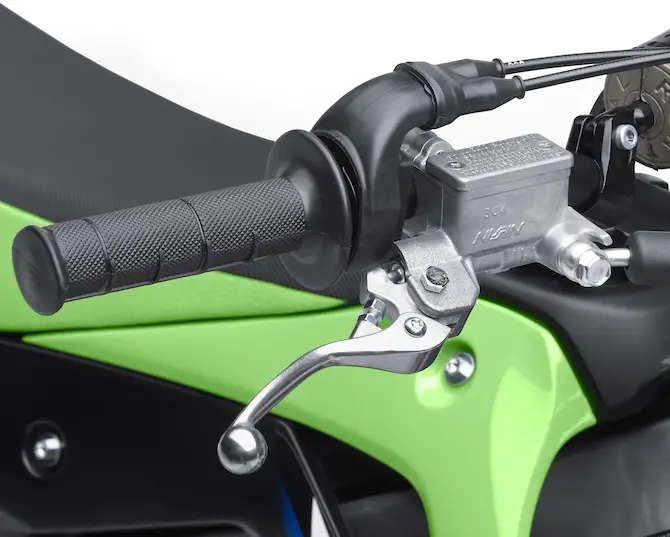
New front master cylinder features a knocker-style lever-to-piston interface for improved feel and more consistent performance than the old piston-type unit.
New front brake pads offer a higher coefficient of friction for stronger braking force and enhanced feel.
New front brake hose is 30mm longer than last year.
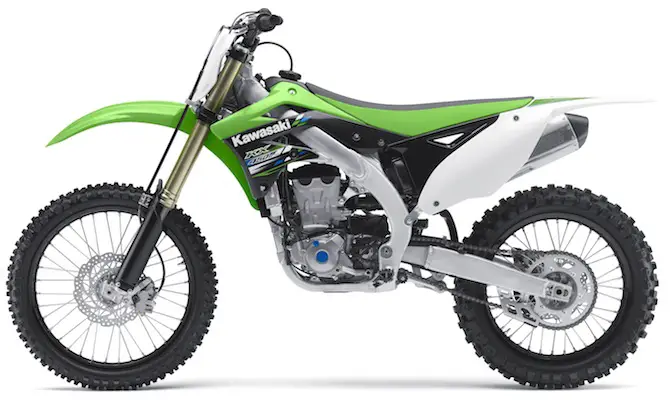
HIGH-PERFORMANCE MULTI-MAP ECU
Revised ignition timing boosts response when re-opening the throttle after deceleration (when landing jumps, etc.).
ECU programming is easily selectable via interchangeable DFI coupler caps that provide three preprogrammed maps for Standard, Hard (terrain) and Soft (terrain), without the need for a programming computer.
The engine can be started with only three rotations of the crankshaft using the electricity generated by a single kick of the starter, no battery needed.
The system delivers electricity to the bike’s electronics in sequence: first the ECU, then the fuel pump, and finally the injector for quick, easy starting.
The compact, lightweight ECU, located on the front of the steering head behind the number plate, was designed specifically for motocross use. The fuel pump relay is integrated with the ECU to help cope with the shocks and vibrations of tough racing.
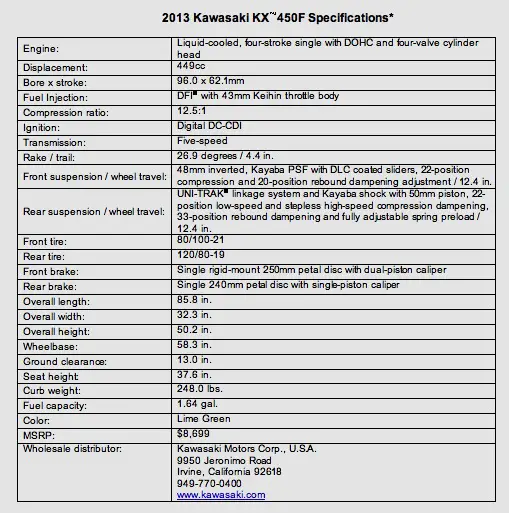





Comments are closed.